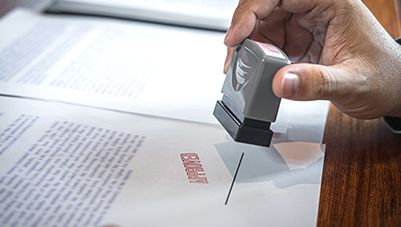Rs. 5,000 - Rs. 2 crore
To find the nearest gold loan branch,
Enter phone and OTP | Check amount you can get | Apply for quick funds
How can you check if your gold is real?
To determine if gold is genuine, you can employ various methods:
- Check for hallmarks: Look for stamps or hallmarks on the jewellery, indicating its purity level. This is a common method of gold identification to ensure you're dealing with original gold.
- Magnet test: Use a magnet near the gold item; real gold is not magnetic. This simple test helps differentiate real gold from artificial gold.
- Scratch test: Rub the gold against a ceramic plate - real gold leaves a golden streak. This is a straightforward way to identify gold at home.
- Density test: Measure the weight and volume of the gold to calculate its density. This method is useful for distinguishing original gold from fake gold coins or jewellery.
- Professional assistance: Seek professional assistance from jewellers or gold experts who can use specialised equipment to authenticate the gold. This ensures the most accurate verification.
Employing a combination of methods such as checking for hallmarks, conducting magnet and scratch tests, and calculating density, alongside seeking expert advice, ensures a comprehensive approach to verifying the authenticity of gold. These steps provide reassurance when purchasing or owning gold items, safeguarding against fake gold and ensuring that your investment retains its value. By taking proactive measures to authenticate gold, you can make informed decisions and confidently navigate the world of gold jewellery and investments.
Methods to check real gold
- Check for Hallmarks: Look for stamps or hallmarks on the jewellery, indicating its purity level. This is a reliable method for gold identification and confirming it's original gold.
- Magnet Test: Use a magnet near the gold item; real gold is not magnetic. This helps distinguish between real gold and artificial gold.
- Scratch Test: Rub the gold against a ceramic plate. Original gold leaves a golden streak, whereas artificial gold may leave a black or grey mark.
- Density Test: Measure the weight and volume of the gold to calculate its density. Real gold has a higher density compared to fake gold coins or jewellery.
- Professional Assistance: Seek help from jewellers or gold experts who can use specialised equipment to authenticate the gold, ensuring accurate gold identification.
How to check gold at home
Checking gold at home can be done effectively with a few simple methods:
- Hallmarks and stamps: Look for marks on the gold jewellery indicating its purity level. This initial check is crucial for identifying gold at home and confirming its authenticity.
- Magnet test: Use a magnet near the gold item; real gold is nonmagnetic, while fake gold will attract the magnet.
- Scratch test: Rub the gold against a ceramic surface; genuine gold will leave a golden streak, whereas fake gold may leave a black mark due to other metals mixed in.
- Density measurement: Calculate the density by weighing and measuring the volume of the gold piece. Original gold has a higher density than most fake gold coins or jewellery.
These methods combined provide a reliable way to assess and verify gold at home without needing specialised equipment, ensuring confidence in your gold items.
Difference between fake and real gold
Identifying fake and real gold is important to safeguard your money and avoid fraud. Real gold does not tarnish or lose its shine and usually carries purity hallmarks. Fake gold, on the other hand, may fade, flake, or even get pulled by a magnet. It also tends to feel lighter compared to genuine gold of the same size. Simple checks like visual inspection, magnet testing, and hallmark verification can help. For complete certainty, consulting a certified jeweller ensures accuracy and protects your investment.
| Feature | Real Gold | Fake Gold |
|---|---|---|
| Shine/Durability | Keeps shine, does not tarnish | Fades or discolours easily |
| Hallmark/Purity Mark | Present, shows purity | Absent or unclear |
| Magnet Test | Not attracted to magnets | May stick to magnets |
| Weight | Feels heavier and dense | Often lighter in weight |
What is real gold?
Real gold is a natural precious metal known for its bright yellow colour, shine, and durability. Unlike fake metals, it does not rust, tarnish, or corrode, which makes it valuable for jewellery, coins, and investments. The purity of gold is measured in karats—24K is purest, while 22K and 18K are mixed with other metals for strength. In India, BIS hallmark certification assures buyers of authenticity. Real gold feels dense, non-reactive, and retains its shine over time. To protect your investment, always check hallmark stamps, buy from trusted jewellers, and verify purity before purchasing.
Quick tip: Wondering how much you can borrow on your gold? Just check your gold loan eligibility—it takes seconds and minimal paperwork!
How to identify real gold at home
If you are wondering how to identify gold without visiting a jeweller, there are a few easy tests you can try. These methods give you a fair idea, but for complete accuracy, expert help is always best.
- Magnet test: Real gold is not magnetic. If it sticks to a magnet, it may be fake or mixed with other metals.
- Float test: Drop the item in water. Genuine gold sinks quickly as it is dense, while fake pieces may float or fall slowly.
- Acid test: Applying nitric acid shows results—real gold stays unaffected, while fake changes colour.
- Hallmark check: Always inspect for hallmarks to confirm purity and authenticity.
These simple steps explain how to check real gold at home.
What are the differences between real gold coins and fake gold coins?
Telling real gold coins apart from fake ones is important to protect your money. Real coins are made of 22-karat or 24-karat gold and usually come with proper certification. Fake coins are often made of cheaper metals like copper or brass, sometimes just coated with a thin gold layer.
Key differences to check:
- Purity and certification: Real coins have hallmarking stamps showing purity, issuing authority, and sometimes minting year.
- Weight and feel: Gold is heavy, so genuine coins feel solid, while fake ones feel lighter.
- Design details: Authentic coins have sharp, clean designs, unlike fake ones with blurred edges or uneven colours.
- Tests: Use magnet or acid tests if unsure and always buy from certified dealers.
How to identify fake and real gold coins
Identifying fake and real gold coins requires a careful assessment of the coin’s physical characteristics and composition. The magnet test is a useful starting point, as real gold is non-magnetic. If a coin shows any attraction to a magnet, it likely contains metals other than gold. This test is simple and safe to perform at home, though it only rules out coins that may have a high content of magnetic metals.
The acid test is another effective way to determine the authenticity of a gold coin. By applying a small drop of nitric acid to a non-visible area, you can observe the reaction. Real gold remains unaffected by the acid, while fake coins made of other metals will react, often showing discolouration or spots. This test is highly reliable but should be conducted with caution, using gloves and safety gear.
You can also check the coin’s markings and certifications. Genuine gold coins come with hallmark stamps that display information such as the gold's purity, the issuing authority, and sometimes the year of minting. Fake coins may have markings as well, but they are often less precise or completely missing. Look for these stamps and verify their authenticity through reputable minting sources.
When purchasing gold coins, it’s recommended to buy from well-known, certified dealers who provide certificates of authenticity. These certificates include information on the coin's origin, composition, and authenticity, offering you peace of mind that you’re investing in genuine gold.
Importance of gold purity for gold loan eligibility
When applying for a gold loan, one of the most critical factors determining your eligibility and the loan amount you can secure is the purity of the gold you pledge. Financial institutions base their loan amount largely on the value of the gold, which is closely tied to its purity level. Typically, lenders prefer 22-karat gold or higher for gold loans, as this is considered a high-purity standard and provides greater assurance of value.
Gold that meets purity standards (usually hallmarked gold) commands a higher valuation, allowing borrowers to access a more substantial loan amount. For example, a 22-karat gold item will generally secure a higher loan than an 18-karat item, as it contains a greater percentage of pure gold. In addition to enhancing the loan amount, higher-purity gold often qualifies the borrower for more favourable interest rates, given its stable value.
Another factor lenders consider is the type of gold being pledged, such as jewellery or coins, as this may impact loan terms and eligibility requirements. However, many institutions are selective with coins, only accepting certain sizes and purity levels. Therefore, if you’re planning to use your gold as collateral, ensuring it meets high-purity standards could significantly improve your chances of meeting gold loan eligibility requirements and securing favourable terms. In summary, ensuring your gold’s purity is not just a matter of value but a strategic move to improve your gold loan eligibility. You can maximise your loan amount and benefit from lower interest rates by pledging high-purity gold, making it easier to achieve your financial goals.
Apply in minutes. Money in account instantly with a Bajaj Finserv Gold Loan*
Best practices for testing gold before getting a loan
Testing your gold before approaching a lender for a loan is essential to ensure you get an accurate valuation and avoid any unexpected deductions due to impurities. Start by verifying the hallmark on your gold item. The BIS hallmark, widely recognised in India, provides details about the gold’s purity and authenticity. A BIS-certified piece gives lenders confidence in the item’s value, helping secure a better loan offer.
Another effective practice is to conduct a karat testing. Many jewellers offer karat analysis services, which can confirm the gold’s purity percentage. For example, a 22-karat gold item should contain approximately 91.6% gold. Accurate karat testing avoids undervaluation and increases your loan prospects.
Consider using the magnet test as an initial, simple check. Since gold is non-magnetic, it won’t be attracted to a magnet. While this doesn’t confirm purity levels, it helps rule out counterfeit metals in the item. The acid test is another trusted method, particularly for jewellery and coins. By applying a small amount of nitric acid to the item, you can confirm purity, as real gold will not react to acid.
Finally, get a valuation certificate from a reputable jeweller. This certificate details your gold’s karat, weight, and approximate value, providing a reference point for negotiations with lenders. By following these best practices, you ensure that your gold meets the lender’s purity standards, paving the way for a seamless and higher-value loan process.
Conclusion
In conclusion, ensuring the purity of gold, verifying hallmarks, and staying updated on gold rates are paramount steps for any gold investor or purchaser. These measures not only safeguard against counterfeit or low-quality gold but also provide assurance of the metal's authenticity and value. By leveraging Bajaj Finance's gold rate in India, investors can make informed decisions, confidently navigate the gold market, and maximise the potential of their gold investments.
Discover your borrowing potential by checking your gold loan eligibility. It takes just a few clicks and no waiting.
Related Articles

Gold Loan Repayment options processing fee and part-prepayment charges
Read More

Should you take a Gold Loan or sell your gold when you need funds
Read More

How to Transfer your Gold Loan to Bajaj Finance
Read More

How to Check Purity for 20 Karat gold
Read More
Disclaimer
Bajaj Finance Limited has the sole and absolute discretion, without assigning any reason to accept or reject any application. Terms and conditions apply*.
For customer support, call Personal Loan IVR: 7757 000 000









 Personal Loan
Personal Loan Check Eligibility
Check Eligibility Salaried Personal Loan
Salaried Personal Loan EMI Calculator
EMI Calculator Account Aggregator
Account Aggregator Credit Pulse Report
Credit Pulse Report
 Deals starting @99
Deals starting @99 Min. 50% off
Min. 50% off
 Bajaj Pay
Bajaj Pay Wallet to Bank
Wallet to Bank
 Easy EMI Loan
Easy EMI Loan Savings Offer
Savings Offer Smartphones
Smartphones Led TVs
Led TVs Washing Machines
Washing Machines Laptops
Laptops Refrigerators
Refrigerators Air Conditioner
Air Conditioner Air Coolers
Air Coolers
 Loan Against Shares
Loan Against Shares Loan Against Mutual Funds
Loan Against Mutual Funds Loan Against Insurance Policy
Loan Against Insurance Policy ESOP Financing
ESOP Financing Easy EMI Loan
Easy EMI Loan Two-wheeler Loan
Two-wheeler Loan Loan for Lawyer
Loan for Lawyer Industrial Equipment Finance
Industrial Equipment Finance Industrial Equipment Balance Transfer
Industrial Equipment Balance Transfer Industrial Equipment Refinance
Industrial Equipment Refinance Personal Loan Branch Locator
Personal Loan Branch Locator Used Tractor Loan
Used Tractor Loan Loan Against Tractor
Loan Against Tractor Tractor Loan Balance Transfer
Tractor Loan Balance Transfer Flexi
Flexi View All
View All
 Two-wheeler Loan
Two-wheeler Loan Bike
Bike Scooter
Scooter Electric Vehicle
Electric Vehicle Best Sellers
Best Sellers Popular Brands
Popular Brands

 Trading Account
Trading Account Open Demat Account
Open Demat Account Margin Trading Financing
Margin Trading Financing Share Market
Share Market Invest in IPO
Invest in IPO All stocks
All stocks Top gainers
Top gainers Top losers
Top losers 52 week high
52 week high 52 week low
52 week low Loan against shares
Loan against shares
 Home Loan
Home Loan Transfer your existing Home loan
Transfer your existing Home loan Loan against Property
Loan against Property Home Loan for Salaried
Home Loan for Salaried Home loan for self employed
Home loan for self employed Loan Against Property Balance Transfer
Loan Against Property Balance Transfer Home Loan EMI Calculator
Home Loan EMI Calculator Home Loan eligibility calculator
Home Loan eligibility calculator Home Loan balance transfer
Home Loan balance transfer View All
View All
 Term Life Insurance
Term Life Insurance ULIP Plan
ULIP Plan Savings Plan
Savings Plan Family Insurance
Family Insurance Senior Citizen Health Insurance
Senior Citizen Health Insurance Critical Illness Insurance
Critical Illness Insurance Child Health Insurance
Child Health Insurance Pregnancy and Maternity Health Insurance
Pregnancy and Maternity Health Insurance Individual Health Insurance
Individual Health Insurance Low Income Health Insurance
Low Income Health Insurance Student Health Insurance
Student Health Insurance Group Health Insurance
Group Health Insurance Retirement Plans
Retirement Plans Child Plans
Child Plans Investment Plans
Investment Plans
 Business Loan
Business Loan Secured Business Loan
Secured Business Loan Loan against property
Loan against property Loans against property balance transfer
Loans against property balance transfer Loan against shares
Loan against shares Home Loan
Home Loan Loans against mutual funds
Loans against mutual funds Loan against bonds
Loan against bonds Loan against insurance policy
Loan against insurance policy
 Apply for Gold Loan
Apply for Gold Loan Transfer your Gold Loan with Us
Transfer your Gold Loan with Us Gold Loan Branch Locator
Gold Loan Branch Locator
 ULIP Plan
ULIP Plan Savings Plan
Savings Plan Retirement Plans
Retirement Plans Child Plans
Child Plans Free Demat Account
Free Demat Account Invest in Stocks
Invest in Stocks Invest in IPO
Invest in IPO Margin Trading Facility
Margin Trading Facility Fixed Deposit Branch Locator
Fixed Deposit Branch Locator
 Check your Credit Score
Check your Credit Score
 New Car Loan
New Car Loan Used Car Loan
Used Car Loan Loan Against Car
Loan Against Car Car Loan Balance Transfer and Top-up
Car Loan Balance Transfer and Top-up
 Get Bajaj Prime
Get Bajaj Prime
 Mobiles on EMI
Mobiles on EMI Electronics on EMI Offer
Electronics on EMI Offer  Iphone on EMI
Iphone on EMI LED TV on EMI
LED TV on EMI Refrigerator on EMI
Refrigerator on EMI Laptop on EMI
Laptop on EMI Kitchen appliances on EMI
Kitchen appliances on EMI Washing machines
Washing machines
 Personal Loan EMI Calculator
Personal Loan EMI Calculator Personal Loan Eligibility Calculator
Personal Loan Eligibility Calculator Home Loan EMI Calculator
Home Loan EMI Calculator Home Loan Eligibility Calculator
Home Loan Eligibility Calculator Good & Service Tax (GST) Calculator
Good & Service Tax (GST) Calculator Flexi Day Wise Interest Calculator
Flexi Day Wise Interest Calculator Flexi Transaction Calculator
Flexi Transaction Calculator Secured Business Loan Eligibility Calculator
Secured Business Loan Eligibility Calculator Fixed Deposits Interest Calculator
Fixed Deposits Interest Calculator Two wheeler Loan EMI Calculator
Two wheeler Loan EMI Calculator New Car Loan EMI Calculator
New Car Loan EMI Calculator Used Car Loan EMI Calculator
Used Car Loan EMI Calculator All Calculator
All Calculator Used Tractor Loan EMI Calculator
Used Tractor Loan EMI Calculator
 Hot Deals
Hot Deals Clearance Sale
Clearance Sale Kitchen Appliances
Kitchen Appliances Tyres
Tyres Camera & Accessories
Camera & Accessories Mattresses
Mattresses Furniture
Furniture Watches
Watches Music & Audio
Music & Audio Cycles
Cycles Mixer & Grinder
Mixer & Grinder Luggage & Travel
Luggage & Travel Fitness Equipment
Fitness Equipment Fans
Fans
 Personal Loan for Doctors
Personal Loan for Doctors Business loan for Doctors
Business loan for Doctors Home Loan
Home Loan Secured Business Loan
Secured Business Loan Loan against property
Loan against property Secured Business Loan Balance Transfer
Secured Business Loan Balance Transfer Loan against share
Loan against share Gold Loan
Gold Loan Medical Equipment Finance
Medical Equipment Finance
 Engagement Zone
Engagement Zone Game Zone
Game Zone
 Savings Offer
Savings Offer Easy EMI
Easy EMI Offer World
Offer World 1 EMI OFF
1 EMI OFF New Launches
New Launches Zero Down Payment
Zero Down Payment Clearance Sale
Clearance Sale Bajaj Mall Sale
Bajaj Mall Sale
 Mobiles under ₹20,000
Mobiles under ₹20,000 Mobiles under ₹25,000
Mobiles under ₹25,000 Mobiles under ₹30,000
Mobiles under ₹30,000 Mobiles under ₹35,000
Mobiles under ₹35,000 Mobiles under ₹40,000
Mobiles under ₹40,000 Mobiles under ₹50,000
Mobiles under ₹50,000
 Articles
Articles
 Overdue Payments
Overdue Payments Other Payments
Other Payments
 Document Center
Document Center Bank details & Documents
Bank details & Documents Tax Invoice Certificate
Tax Invoice Certificate
 Do Not Call Service
Do Not Call Service
 Hamara Mall Orders
Hamara Mall Orders

 Fixed Deposit (IFA) Partner
Fixed Deposit (IFA) Partner Loan (DSA) Partner
Loan (DSA) Partner Debt Management Partner
Debt Management Partner EMI Network Partner
EMI Network Partner Became a Merchant
Became a Merchant Partner Sign-in
Partner Sign-in
 Mobiles on EMI
Mobiles on EMI Trade directly with your Demat A/c
Trade directly with your Demat A/c ITR
ITR My Garage
My Garage
 Live Videos - Beta
Live Videos - Beta
 Savings Offer
Savings Offer Smartphones
Smartphones LED TVs
LED TVs Washing Machines
Washing Machines Laptops
Laptops Refrigerators
Refrigerators Air Conditioners
Air Conditioners Air Coolers
Air Coolers Water Purifiers
Water Purifiers Tablets
Tablets Kitchen Appliances
Kitchen Appliances Mattresses
Mattresses Furniture
Furniture Music and Audio
Music and Audio Cameras & Accessories
Cameras & Accessories Cycle
Cycle Watches
Watches Tyres
Tyres Luggage & Travel
Luggage & Travel Fitness Equipment
Fitness Equipment Tractor
Tractor Easy EMI Loan
Easy EMI Loan
 vivo Mobiles
vivo Mobiles OPPO Mobiles
OPPO Mobiles Xiaomi Mobiles
Xiaomi Mobiles Sony LED TVs
Sony LED TVs Samsung LED TVs
Samsung LED TVs LG LED TVs
LG LED TVs Haier LED TVs
Haier LED TVs Godrej Refrigerators
Godrej Refrigerators Voltas Washing Machines
Voltas Washing Machines
 New Tractor Loan
New Tractor Loan Used Tractor Loan
Used Tractor Loan Loan Against Tractor
Loan Against Tractor Tractor Loan Balance Transfer
Tractor Loan Balance Transfer







